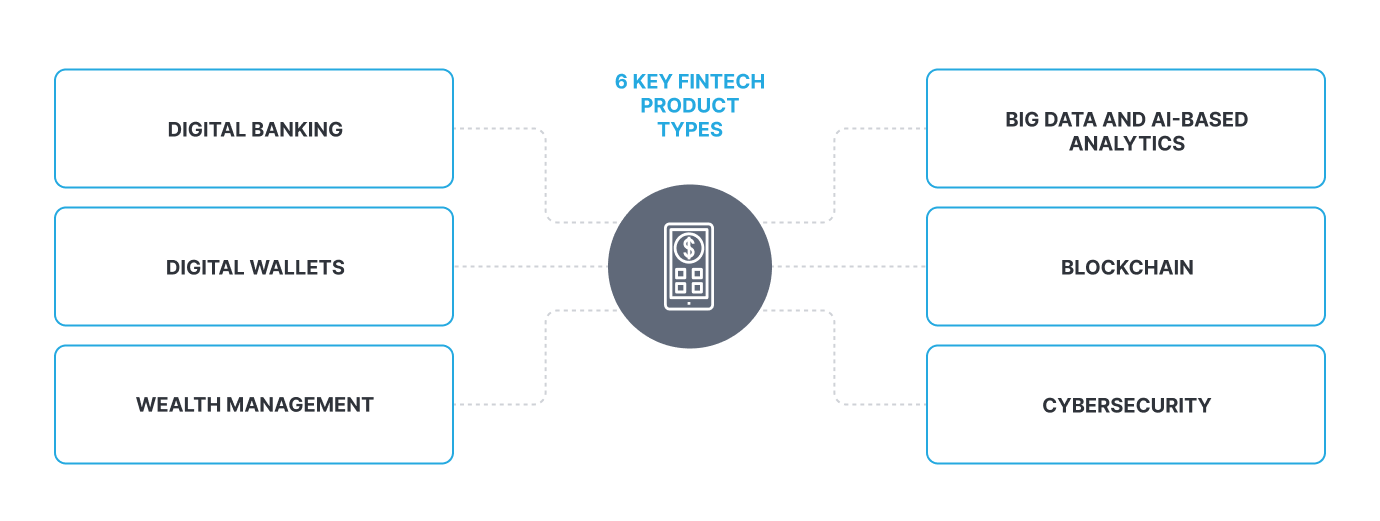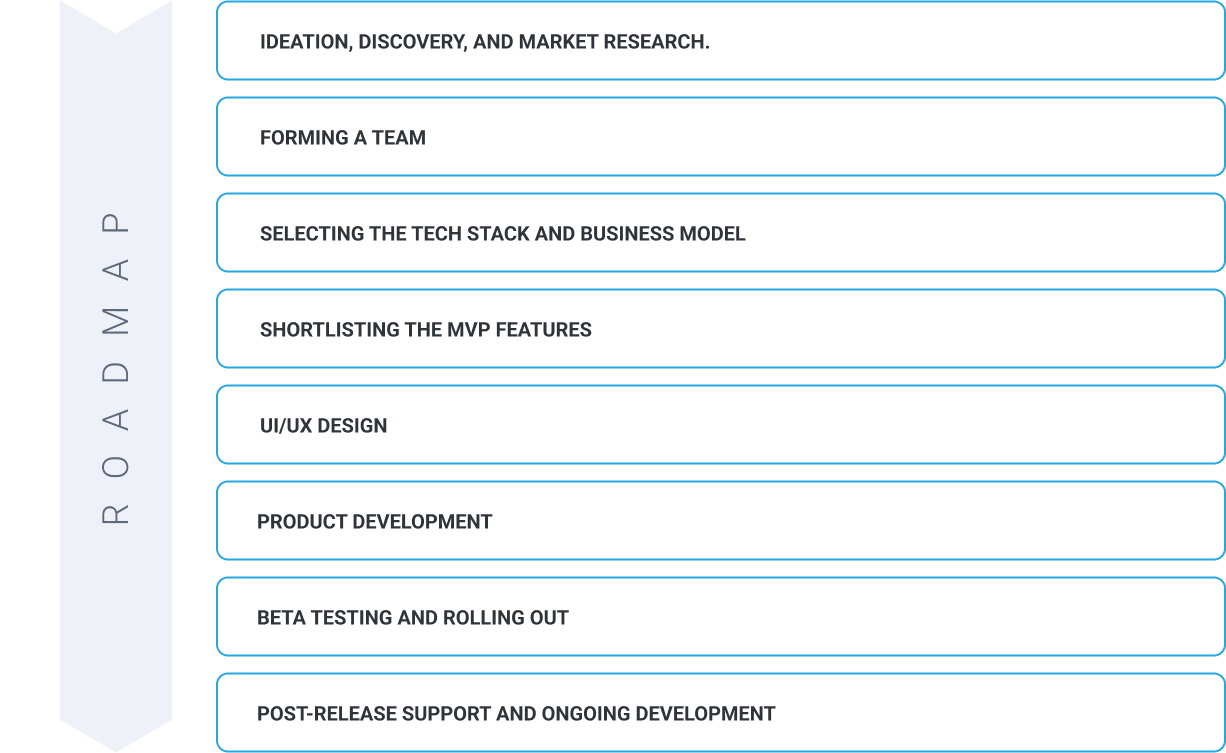Fintech Strategy Roadmap for a Great Fintech Product
May 19, 2023
FinTech
Development

Table of contents
Fintech product development was considered a gift that kept on giving throughout the last decade, especially during the pandemic. People wanted to manage their money remotely, IT companies and startups kept hiring in the hope of future growth, and global fintech investment reached an all-time high in 2021, nearly topping $240 billion.
But 2022-2023 saw a sharp decline in fintech investment as VC funds and other investors rushed to prepare for an upcoming economic downturn. Big Tech and startups worldwide cut hundreds of thousands of employees — but this does not mean people don’t need fintech apps anymore. Quite the contrary, 65% of Americans used digital banking in 2022, and this number is sure to grow.
What it means, though, is that VC funds prefer to invest only in products with tangible promises of greatness, not in vague entrepreneurial visions. So, the question is — how to build a great fintech product in 2023? What features should it have, what roadblocks to expect, and how to deal with them? Fintech strategy roadmap will help you find the answers to all these questions!
Let’s start with the types of fintech apps you might want to develop.
What is Fintech Strategy Roadmap and Why it’s Important
A fintech strategy roadmap refers to a well-structured, clear, and concise plan that includes all the important steps and milestones needed to be implemented to achieve your project goals. It's a comprehensive document that serves as a guideline, helping you make correct decisions throughout your development process and evaluate the project's performance while keeping the main objectives in focus.
It's hard to overestimate the importance of a fintech strategy roadmap, as it helps outline the primary company's growth vectors. It includes a lot of data regarding the fintech market, your target audience, and competitors. It identifies potential challenges, evaluates the tech and business infrastructure needed for your project, and outlines plans for future innovations. It also explores opportunities for strategic collaborations and partnerships, etc.
So, a fintech strategy roadmap is the foundation that'll shape the entire development journey for your app. Sure, whipping up this roadmap might take a bit, but trust us, it's like putting in the groundwork for a solid game plan. By diving deep into the nitty-gritty and planning things out right from the get-go, you're basically setting your project up to dodge those painful and wallet-draining blunders down the road.
When building a fintech app from scratch, we always start with the creation of a fintech strategy roadmap before delving into the tech part. Thanks to our profound experience in the fintech niche and the deep expertise of our analytics, we know the drill and can help you focus on the crucial things for your project.
Discover Your Fintech Potential with Expert Guidance!

Volodymyr Khodonovych
Fintech Development Expert
Explore the realm of fintech innovation with Perfsol's full-cycle product development services. From ideation to launch, we will guide you through creating a fintech product that stands out in the market. Contact us today, and let's shape the future of finance together!
6 Key Fintech Product Types
Correct product positioning is a major success factor in fintech software development. While there are innumerable fintech apps in every line of business, all of them can be roughly split into the following categories:

- Digital banking. Whether building a product for a single bank or a multi-banking platform with access to multiple payment gateways, there always is room for growth. Global digital banking development market evaluation is $6.9 billion in 2023, projected to nearly double, reaching $11.4 by 2027, so new entrants can hope for a piece of this pie.
- Digital wallets. Moving money across the globe has never been easier. Giants like PayPal, Venmo, Paysend, or Wise are growing rapidly, but there still is a nearly 1.4 billion underbanked population worldwide. How many millions of them will use your digital wallet in a couple of years?
- Wealth management. Digital management of finances and investments is steadily gaining pace. New B2B and B2C customers are driven to this field as they find assessing and managing their assets through a mobile app super convenient.
- Big Data and AI-based analytics. From currency exchange to stock markets and from decentralized finances to healthcare and insurance — volumes of data generated are enormous and growing daily. By employing AI algorithms to analyze them, companies can get actionable business insights from the flow of raw data faster.
- Blockchain. Speaking about DeFi, despite the huge Bitcoin meltdown in 2022, the blockchain arena is still going strong. The benefits of immutable decentralized transaction ledgers are indisputable and are finding new and new applications in various domains, from holding real estate deals in Georgia since 2017 to being the “glue for the future energy grid.”
- Cybersecurity. Fintech is gradually moving towards superapps like Chinese WeChat, which provides a wide range of functionality, from communication to paying utility bills, micro-lending, automated subscription payments, and more. Cybersecurity features are important for all fintech apps but are absolutely essential for superapps, which interact with dozens or hundreds of third-party platforms and act as a single point of access to all of them.
The list is not exhaustive, of course, as there are highly-specialized products for healthcare, mortgages, tax management, and more. The final list is dictated by the niche you select for your future product.
Must-have Features of Fintech Apps

Naturally, there are area-specific features that don’t need to be present in all kinds of fintech software. However, there are mandatory features that any sort of fintech software must include. Fintech strategy roadmap helps differentiate it and prioritize in the right way. For instance, both blockchain apps and digital wallets must have integrations with payment gateways, not to mention login/registration and general dashboards. Let’s discuss these next.
User registration/login
Whichever type of fintech app you develop, its users must be able to register and securely log in. Registration entails anti-fraud checks to filter out scammers with throwaway credentials, and login must run some form of security check, like two-factor authentication (2FA) or Touch/Face ID.
Dashboard
All the functionality your product provides must be organized into a neat and intuitive dashboard. Mobile banking apps can split it into multiple screens by using swipes left and right, while desktop or web-based platforms usually have multiple drop-down menus and sidebars with various tools. It is also essential to make access to FAQ, knowledgebase, and support center from the dashboard as simple and visible as possible.
Payment gateways
Whatever the ultimate goal of your product, you would want your customers to be able to transfer money and pay for services at some point. Integrating one or more popular payment gateways like PayPal, Stripe, or Skrill is a must-have.
Cybersecurity
Naturally, you should protect the sensitive financial and PII details your customers provide you with and do it throughout the customer journey, not on login only. It is wise to use 3-D Secure verification, 2FA, or even blockchain ledgers while making payments, issuing invoices, or forming orders for products and services.
QR code scanning
QR codes are an excellent way to provide fast and easy access to important information, verify money transfers, or even refer your product to a friend. Thus, developing a QR scanner is a smart idea for nearly any type of fintech software.
Push notifications
Fintech software is all about agility and convenience in making financial decisions, so keeping your customers informed about the essential updates in their accounts is paramount. Whether it is an incoming payment request awaiting approval or confirmation for logging in through a web-based interface — push notifications will always come in handy.
Personalization
This is one way to keep your customers satisfied without affecting the platform’s performance. Allow users to change fonts or text color, switch between light or dark themes, have their own avatars, or use emojis in texts — and they will feel cared for, which is the right way towards brand loyalty.
FAQ, tips, pop-up details
Your product will be used by multiple audiences with varying degrees of technical background. What might seem self-explanatory to one will not be as plain to others. Consider adding tips, an FAQ section, and pop-up explanations of functionality to ensure people are satisfied when using your app.
As we said, these are just the must-have features, and the full list will depend on your product idea, business logic, and development budget. Let’s now discuss how to transform the idea into working software.
Roadmap to Creating a Great Fintech Product
To succeed with fintech product development, it is not enough to create a feature-rich platform. The key goal is to ensure it solves particular pains of your audience — that’s exactly why you need a fintech strategy roadmap.
- Ideation, discovery, and market research. Articulate your idea and what pain you are trying to solve with it. Take a look at competitors and check if there are any similar products in this niche. Research their features, as well as positive and negative feedback. Knowing where others failed to meet their audience expectations will help you exceed them.
It is also prudent to start marketing your product at this stage. Gathering user feedback and forming focus groups will help better define customer expectations and run beta testing.
- Forming a team. You might already have the needed experts in-house or opt to employ them, outsource the job to a fintech development company like Perfsol or even hire freelancers.
- Selecting the tech stack and business model. With sufficient expertise, you can choose the best frontend and backend technologies, cloud services, and additional tools like AI or blockchain to use in your new app. Compliance and licensing should also be handled at this stage, as well as monetization.
- Shortlisting the MVP features. There will be a lot of nice-to-haves — there always are. The key here is to shortlist the features that are absolutely necessary for the product to deliver on its promise. These should be packed into an MVP, while the rest can be added with time.
- UI/UX design. Building clickable prototypes, mockups, and wireframes, as well as assessing the transparency of business logic — all of this goes into this phase. It also proves the credibility of your initial ideas: we’ve seen some features that seemed great on paper being truncated or postponed while developing an MVP.
- Product development. Once the designs are ready, it’s time to develop features that will come into the MVP. This version should be made available for alpha testing by stakeholders and focus groups. At Perfsol, we can’t emphasize the importance of this step enough. Make all the new functionality added after each development sprint immediately available to stakeholders to ensure the project moves along the expected tracks.
- Beta testing and rolling out. Once the MVP is ready, it’s time for a beta-testing by users. Note that all the basic testing — unit and integration, reverse-compatibility and reliability engineering, automation, and performance testing — should be done during the development.
But opening the product to a wider audience allows you to see how real users will interact with it — and some of their questions and ideas can be really baffling. Once these are addressed, it’s time to officially release the product.
- Post-release support and ongoing development. If your product gains traction and forms a growing following — go on and add the rest of the features based on your strategy and user feedback.
While this roadmap looks pretty straightforward, it’s crucial to follow it. At Perfsol, we’ve had several cases when we had to help our customers refactor the deliverables they had to get their projects back on track.
Final thoughts
Fintech software development can yield outstanding results if done right. Despite the looming recession, digital banking and other types of fintech apps are not going anywhere. However, it is pretty troublesome to do everything correctly from the get-go. In fact, according to Google’s 2020 Fintech Pulse Report, only 6% of fintech startups break even.
How to ensure your product is among them?
- Spare no time and effort on the preliminary research and discovery phase. Ensure you have sufficient expertise and follow the correct roadmap to ensure product quality and optimal resource allocation.
- Build a product that solves your audience’s pain but pay close attention to your customers’ feedback — and they will love using it!
While the latter is easier said than done, the former is quite doable. Perfsol has ample experience with fintech product development, from redesigning digital wallets to developing feature-rich financial management apps.
Contact us for a detailed consultation on our fintech software development services. We are ready to assist at any stage of your app development journey — from fintech strategy roadmap development to post-release maintenance!
Author
CEO
I follow a proactive approach in life to solve simple to complex problems systematically. I fully understand the nexus of people, process, technology, and culture to get the best out of everyone at Perfsol to grow the businesses and deliver a societal impact at the national and global levels.
FAQ
What is a Fintech Strategy Roadmap and why is it essential for product development?
A Fintech Strategy Roadmap is a comprehensive plan that outlines key steps and milestones essential for achieving project goals in fintech product development. It serves as a guideline, helping make informed decisions, evaluate performance, and stay focused on project objectives throughout the development process.
What are the key types of fintech apps for development in the current market landscape?
Major types of fintech apps include digital banking platforms, digital wallets, wealth management apps, big data and AI-based analytics tools, blockchain applications, and cybersecurity solutions. Each type serves specific financial needs and targets diverse user segments, with potential for significant growth and market expansion.
What are the must-have features for any fintech app to ensure success and user engagement?
Essential features for fintech apps include robust user registration and login systems, intuitive and informative dashboards, integration with popular payment gateways, stringent cybersecurity measures, QR code scanning for easy transactions, push notifications for real-time updates, personalization options for user preferences, and educational resources like FAQs and tips for enhanced user experience and satisfaction.
